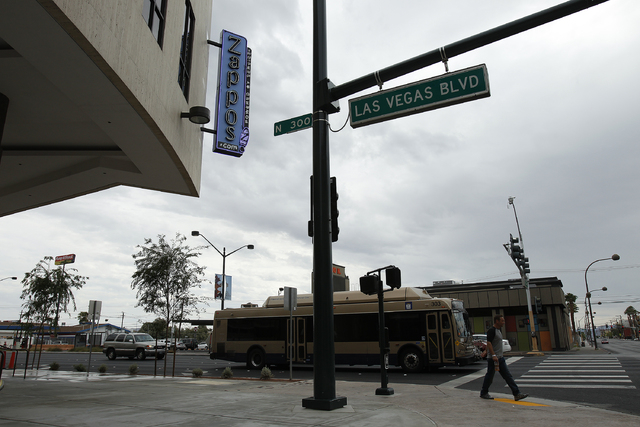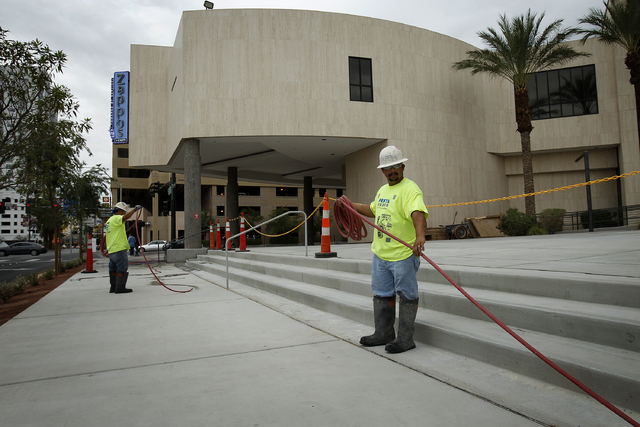Zappos HQ: Business brings money and presence to revitalize downtown
If you’re looking for the Zappos effect in downtown Las Vegas it helps to wake up early.
That’s when things start to stir at Rachel’s Kitchen on the ground floor of The Ogden, an upscale residential tower and home to Zappos CEO Tony Hsieh and friends.
Customers mill about waiting for their morning coffee and muffin even before the cafe opens at 7 a.m., and they keep coming all day long.
“It has been a real kick in the pants to be down here downtown; it has been really energetic,” co-owner Caron Richardson said. “It is like nonstop. If you can sit down for a couple minutes it is a luxury.”
And it’s about to get even busier. On Monday Zappos, the online shoe seller, will officially open its new headquarters in the former City Hall building at 400 Stewart Ave. The extensively remodeled building will accommodate as many as 2,000 employees, many relocating from the company’s current digs in Henderson.
As the Zappos employees settle into their new downtown workplace they’ll be looking for everything from doggie day care to dry cleaning to restaurants and bars. That means a big boost for businesses around the old City Hall, though it remains to be seen how far that economic ripple effect will extend.
Residential real estate professionals report an uptick in interest in downtown living, but it’s only partly attributed to Zappos. While commercial real estate occupancy rates are better downtown than around the valley, the volume is small.
Regardless, the move means there will soon be more people on the street and more customers for businesses in the downtown core.
“Getting lunch on Fremont Street is going to be slightly challenging; there are going to be a lot of people vying for space,” said Zach Ware, a Zappos contractor who led the City Hall renovation and Zappos’ relocation.
BEYOND COMPANY BUBBLE
Once famous for providing workers with everything from breakfast to booze in the office, Zappos has fashioned its new headquarters with design elements aimed at getting workers to explore the area beyond the company bubble.
Ware contrasted the Zappos campus with other downtown office complexes, such as the Molasky and Bank of America buildings.
“People drive into those buildings in the parking lots, and you never see them again. We are trying to do the exact opposite,” Ware said.
The company will encourage workers to explore downtown during the day and even work in nearby coffee shops or co-working spaces.
And while Zappos plans to retain meal benefits for employees, including an on-campus cafe, the company is considering ways to broaden the meal benefit so that workers can also dine out, Ware said.
“We want to figure out ways to help get some of that money out of our campus,” he said.
The hangup so far is bureaucratic: If Zappos provides meals on campus, there are no tax implications for the recipients. Meal money used elsewhere must be taxed as a bonus.
Even if the company can’t overcome the tax hurdle, employees will have new ways to spend in downtown restaurants.
Andy Hsieh, Tony Hsieh’s brother, founded Lux Delux, which sells a mobile app that helps users order, pay for, and arrange takeout and delivery of meals from downtown restaurants. Rachel’s Kitchen, Le Thai and Triple George are among the restaurants available through the app, according to a product description from the company.
Another way Zappos money might spread money downtown is by paying $25 to $35 per month for each employee to park in existing private lots and garages, rather than building its own, Ware said.
And downtown likely will see a little better nightlife, as employees might be more inclined to socialize after work than they were when their office was in a suburban office park.
HOUSING PRICES UP
Ken Kraft, a Zappos project manager, said he already is spending more time and money downtown since the move was announced.
“By opening up your location you are opening up your mind,” Kraft said. “I definitely see me and my family spending more of our time and money downtown than we ever did in Henderson.”
But will there be new money for more than coffee and cocktails?
Richard Emanuele, of Simply Vegas Real Estate, said a combination of redevelopment, Zappos anticipation and spending by Hsieh’s privately funded Downtown Project have spurred interest in the area.
Emanuele, who owns more than a dozen downtown houses, said the cost per square-foot of some renovated homes in the area has grown from $20 in 2010 to $85 now.
“It is kind of tough to purchase them right now, because there are a lot of investors buying downtown,” he said.
That said, downtown living is still less expensive and more attainable for a $15-an-hour Zappos employee than Henderson has been.
With Zappos occupying about 200,000 square-feet in its headquarters, downtown will reverse an ongoing negative net absorption rate for commercial real estate that characterized the first part of the year.
Downtown’s vacancy rate of 13.9 percent is much lower than the valleywide rate of 22.7 percent, but Suzette LaGrange, a commercial real estate broker, said the outlook for downtown is mixed.
“It is doing substantially better than any other submarket,” she said. “We are kind of treading water.”
And because Zappos is moving within the same metro area, its direct impact on real estate will be a push — downtown’s gain will be offset by Henderson’s loss.
LaGrange also said the Zappos move may not be the start of a trend, with companies wanting to establish a hip vibe to attract young employees who want an urban lifestyle. Just as many companies are sticking with office parks in the ‘burbs.
LaGrange said one company she helped place favored the suburbs in part because of concerns about safety for employees working late at night. She said the Zappos move “will definitely improve that perception.”
SOME LEFT OUT
While enthusiasm for the coming of Zappos runs high downtown, not every business stands to benefit.
“The community he wants to build is hand selected of people he wants,” convenience store operator Steve Yono said of Hsieh. “He is not getting anybody involved who has been there all those years.”
Yono and his brother, Manny, operated a store on Fremont Street just a few blocks from City Hall for about 15 years until their landlord, anticipating the arrival of Zappos and the new businesses sponsored by the Downtown Project, declined to renew their lease.
The brothers moved farther east on Fremont, but Steve Yono said it isn’t the same. He said new property owners are pushing out low-income and fixed-income residents from day motels who provided a steady stream of business to his downtown store.
“Elderly people, the homeless and people who are not well-to-do, they don’t want down there,” Yono said.
Others described changes downtown as an evolutionary process.
John Restrepo, a local economist, said whatever happens will be the result of changing taste and consumer demand.
“You can’t force downtown redevelopment,” Restrepo said. “At some point, it does have to happen organically. We are just at the beginning of that process.”
Contact reporter Benjamin Spillman at bspillman@reviewjournal.com follow on Twitter @BenSpillman702




















